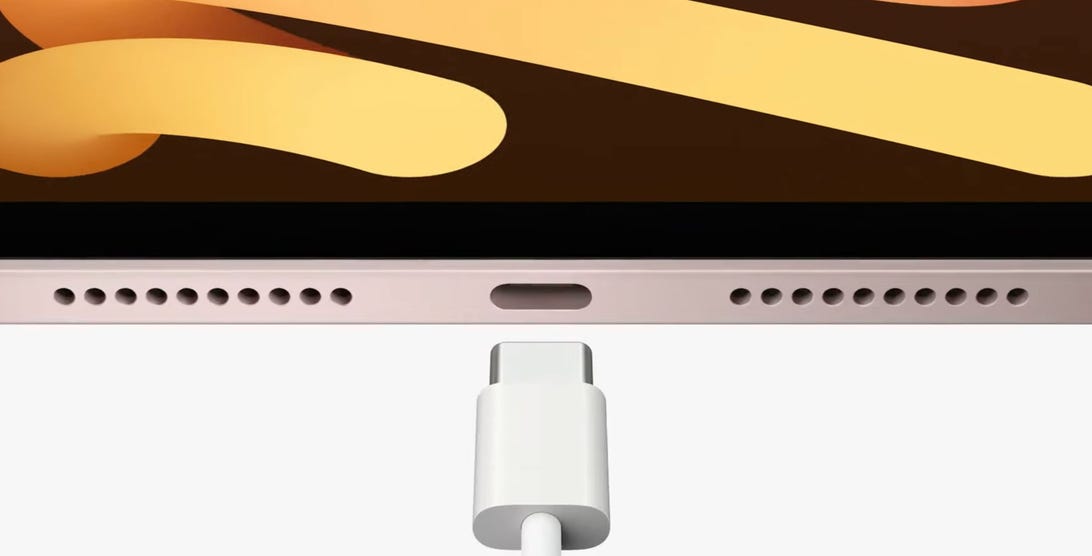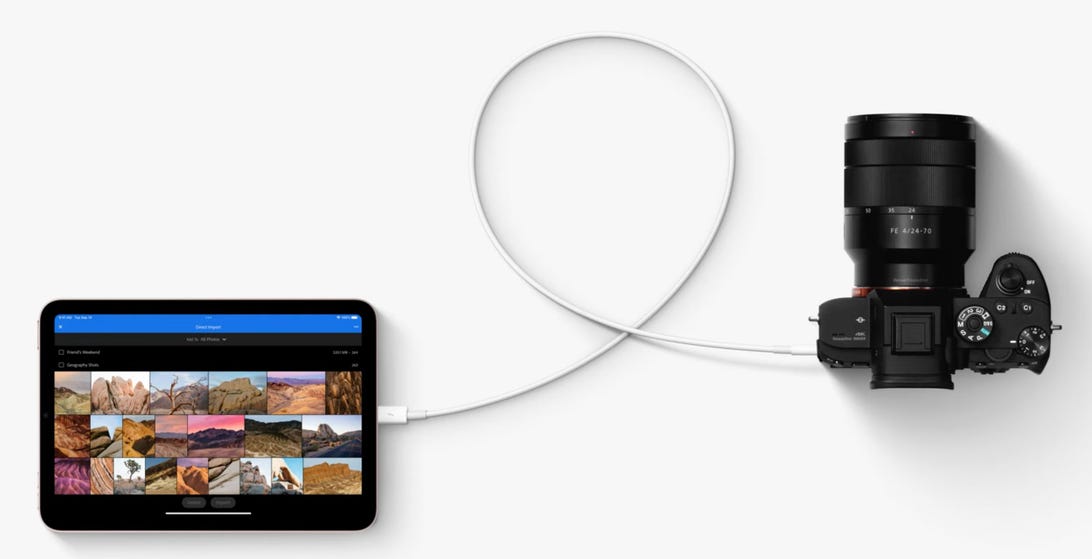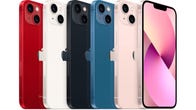
A USB-C port replaces the older Lightning port on the 2021 iPad Mini.
Apple/Screenshot by Stephen Shankland/CNETI like my iPhone, but I'd love it if it had USB-C. So I was cheered this week to see an indication that it might someday.
I wasn't surprised when Apple introduced the iPhone 13 on Tuesday with the same old Lightning port the company has used since 2012. Lightning is fine. But it isn't USB-C.
Here's what I like about USB-C. It's versatile, an industry standard that spans more and more of the electronics world. It transfers data at up to 20 gigabits per second and is jumping to 40Gbps with the new USB 4 data transfer protocol just now arriving. It charges phones, tablets, PCs and anything else that needs up to 100 watts of power, with a 240W upgrade that'll be great for gaming laptops. And there's a growing ecosystem of USB-C accessories, including hubs, docking stations, keyboards, flash drives and memory card readers.
Apple has more or less stuck with Lightning, a proprietary product, for its mobile devices, though its top-end iPad Pro got USB-C in 2018 and the midrange iPad Air got the technology in 2020. (MacBooks debuted USB-C in 2015, a move that prompted some grumbling because it did away with the beloved MagSafe connector.)
Now Apple is providing hints that USB-C could spread. At its event this week, the iPad Mini got a USB-C port, making the device more powerful and flexible. It'll be harder to switch iPhones to USB-C because so many phones and Lightning chargers are already in use, but it increasingly looks like Apple is preparing its formidably large customer base and product ecosystem to make the leap.
Picking apart Apple product announcements is a bit like Cold War Kremlinology: spycraft that attempted to figure out what the Soviet Union was up to by assessing which Russian officials were in or out of favor. The introduction of USB-C to some new devices doesn't necessarily mean Apple is softening the ground for a major change to its most important product line.
Still, I think USB-C is in the iPhone's future. A wholesale transition, while no doubt a big pain, ultimately will be good for you, the iPhone and the planet. You'll get less electronic junk, the iPhone will get more utility and landfills won't be littered with as many cables that only work with a fraction of devices.
Apple didn't comment for this story.
Apple, get with the program
Almost every other corner of the tech world has moved to USB-C for data and charging. Android phones settled on USB-C ports years ago, and it's a fixture in Windows PCs. The price premium for USB-C accessories is easing, too.
I use USB-C for external drives, earbuds, headphones, flash card readers, two laptop docking stations, a Nintendo Switch and its Joy-Cons, iPads, Android phones, hardware security keys, the family's Macs, a Microsoft Surface Laptop and a Google Pixel Slate. I have USB-C chargers in two cars and four rooms in my house. On the road, I use portable batteries with USB-C ports.
The pesky Lightning cable I need for my iPhone is increasingly out of place. Lightning was a fine replacement for the iPhone's older and bulky 30-pin connector, but now USB-C is a much better alternative.
Apple sees the benefits, too. Katie MacDonald, an iPad product manager, said Tuesday that the iPad Mini's USB-C connector is 10 times faster than Lightning and can "connect to a vast ecosystem of USB-C accessories." That's great for everyone from amateur photographers to medical personnel scanning patients with Butterfly portable ultrasound scanners.

An iPad Mini's USB-C connection lets it connect directly to a camera.
Apple/Screenshot by Stephen Shankland/CNETWhy Apple isn't racing to sell USB-C iPhones
With millions of iPhones in use, dumping Lightning connectors won't be easy. Customers have invested in chargers and cables in homes, offices and cars. Lightning is also used in AirPods charging cases and wired Apple earbuds, too.
Moving to USB-C means that Lightning gear has to be replaced. I'm old enough to remember the howls of displeasure when Apple dumped its 30-pin connector, and Lightning today is vastly better established than the old connector was in 2012.
Lightning also has kept iPhones above the fray for some of USB-C's growing pains. It can be hard to tell if a particular cable can handle USB's full power and top data transfer speeds. Some of those issues remain, but USB's advantages outweigh them.
A transition, should one come, would force iPhone loyalists to buy a lot of new cables, a prospect no one is likely to relish. In the long run, though, it'll be worthwhile. Now or soon, you'll likely use USB-C to charge other devices, so switching ultimately reduces your life's electronic clutter. It will also reduce e-waste because you'd need fewer cables to cover most of your devices. You can always donate your old cables to those who still need them.
How about an iPhone with no ports at all?
iPhones could go straight from Lightning connectors to no connectors at all. Connectors pierce holes in a phone's chassis that weaken it, expose it to the elements and increase manufacturing costs.
Wireless charging and data transfer techniques are getting better. With Apple's iCloud, you don't need to back up and sync your iPhone with a cable plugged into your laptop anymore. The best way to get music from your phone to better speakers is with Bluetooth, not a phone docking station.
Charging and data ports, however, will maintain their utility. Nothing beats a cheap copper cable when it comes to fast, private, reliable data transfer. If you've got only a few minutes to spare in the airport or car, rapid charging will boost your battery better than any charging pad.
When it's time to plug that cable into my phone, I vote for USB-C.
https://ift.tt/2VMrKzb
Technology
Bagikan Berita Ini















0 Response to "I want an iPhone with USB-C. Now there are signs Apple does, too - CNET"
Post a Comment